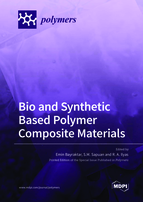Bio and Synthetic Based Polymer Composite Materials
A special issue of Polymers (ISSN 2073-4360). This special issue belongs to the section "Circular and Green Polymer Science".
Deadline for manuscript submissions: closed (31 October 2021) | Viewed by 57219
Special Issue Editors
Interests: mechanical properties; finite element analysis; mechanical behavior of materials; mechanical engineering; fracture mechanics; materials engineering; composites; fracture; finite element method; welding; composite material; damage mechanics; aeronautical engineering
Special Issues, Collections and Topics in MDPI journals
Interests: natural fibre composites; material selection; biobased packaging
Special Issues, Collections and Topics in MDPI journals
2. Centre for Advanced Composite Materials, Universiti Teknologi Malaysia, 81310 UTM Johor Bahru, Johor, Malaysia
Interests: polymer engineering; material engineering; natural fibres; nanocellulose; biopolymer; biodegradable polymer; biocomposites and nanocomposites
Special Issues, Collections and Topics in MDPI journals
Special Issue Information
Dear Colleagues,
Bio and synthetic polymer-based materials including plastic and rubber materials possess unique properties such as resistance to corrosion and chemicals, good durability, low cost, and being easy to manufacture; all this results in their common application in a wide range of industrial branches. Consequently, the implementation of efficient waste management of plastic and rubber materials has become a huge environmental, social and economic problem. Recent advances and developments in polymeric materials based on recycling and bio-based components seem to be a promising solution to this pressing issue. The aims of this Special Issue on recycling polymeric materials in the journal Polymers are:
- To disseminate critical reviews and research findings in the area of the recycling of bio and synthetic polymeric materials, focusing on processing, properties and applications;
- To gather recent research outputs and review papers in the areas of bio and synthesis technology of polymeric material experts worldwide, by giving priority to researchers from technologically advanced countries;
- To strategize for increases in the number of citations for the benefit of the contributors and publisher alike by inviting contributors mostly from technologically advanced countries in the area of bio and synthetic polymeric materials, through the publication of research and review papers.
This Special Issue presents a collection of original research and reviews focused on laboratory- and industrial-scale solutions to the sustainable development of novel and environmentally friendly polymeric materials. The scope of the Special Issue focuses on the recycling of bio and synthetic polymer-based materials: It includes, but is not limited to, the following areas:
- Development of low-cost and pro-ecological recycled polymeric materials;
- Current trends and limitations in the utilization of waste bio and synthetic polymers;
- Management of waste bio and synthetic polymers via compatibilization, functionalization, and modification;
- Structure–property relationships in environmentally friendly materials;
- An investigation of polymer matrix–filler interactions and further improvement of the performance properties in the studied systems;
- Characterization of recycled bio and synthetic polymer composites;
- Properties of biofibre-reinforced recycled bio and synthetic polymer composites;
- Rheological and thermal properties of recycled polymeric materials;
- Fibre treatments in recycled composites;
- Recycle polymers, sharp memory polymers, and polyamides;
- Processing technology of recycled polymeric materials.
Prof. Dr. Emin Bayraktar
Prof. Dr. S. M. Sapuan
Dr. R. A. Ilyas
Guest Editors
Manuscript Submission Information
Manuscripts should be submitted online at www.mdpi.com by registering and logging in to this website. Once you are registered, click here to go to the submission form. Manuscripts can be submitted until the deadline. All submissions that pass pre-check are peer-reviewed. Accepted papers will be published continuously in the journal (as soon as accepted) and will be listed together on the special issue website. Research articles, review articles as well as short communications are invited. For planned papers, a title and short abstract (about 100 words) can be sent to the Editorial Office for announcement on this website.
Submitted manuscripts should not have been published previously, nor be under consideration for publication elsewhere (except conference proceedings papers). All manuscripts are thoroughly refereed through a single-blind peer-review process. A guide for authors and other relevant information for submission of manuscripts is available on the Instructions for Authors page. Polymers is an international peer-reviewed open access semimonthly journal published by MDPI.
Please visit the Instructions for Authors page before submitting a manuscript. The Article Processing Charge (APC) for publication in this open access journal is 2700 CHF (Swiss Francs). Submitted papers should be well formatted and use good English. Authors may use MDPI's English editing service prior to publication or during author revisions.
Keywords
- Recycling
- Environmentally friendly materials
- Recycle biopolymer
- Recycle synthetic polymer
- Recycle biocomposite
- Recycle hybrid composite
- Matrix–filler interactions
- Compatibilization
- Reactive processing









